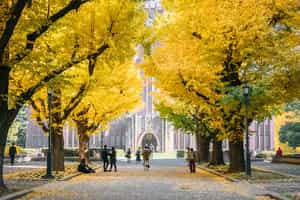- SERVICES
- HIGHER EDUCATION MARKETING
- ENGAGEMENT & ENROLLMENT MANAGEMENT
- STUDENT RECRUITMENT AGENCIES
- PROFESSIONAL EDUCATION & TRAINING
- WHO WE ARE
WHO WE ARE
Learn more about Keystone Education Group, including our leadership structure, why choose Keystone as your educational partner, and company press releases.
QUICK LINKS
- RESOURCES
RESOURCES
Find a range of helpful resources to help with your educational marketing. From on-demand webinars, reports & data, to customer testimonials and our downloadable media kit.
QUICK LINKS
- NEWS
- REQUEST A CALL

Taking Art and Creative Studies Online: Making the Most of the Shift
5 min read
|- Keystone Higher Education News
- Taking Art and Creative Studies Online: Making the Most of the Shift
While many colleges and universities were shifting in the direction of online content delivery prior to COVID-19, the pandemic both accelerated and forced the shift. It’s hardly surprising that there was a learning curve associated with both the abruptness and the scale of the transition. Furthermore, not all areas of study were impacted in the same way or to the same degree. Art and creative studies programs, for example, faced some unique challenges.
Here’s a closer look at how university art and creative studies programs have adapted to virtual learning environments, along with insights on what to expect moving forward.
From Hands-On to Remote Learning
We recently took a look at how university STEM workshops and labs have been reconfigured for virtual delivery. However, the impact of the move to online learning isn’t limited to STEM studies. With the inherently hands-on nature of many art and creative studies degree programs, professors and students alike have had to adapt physical work to the virtual world.
Inside Higher Ed recently featured the experiences of University of Wyoming drawing professor Douglas Russell in reconfiguring his drawing classes for online learning. In addition to introducing modules that allowed students to move at their own pace, Russell has also embraced asynchronous learning to support students who may be facing heightened demands due to the pandemic.
While Russell has prioritized giving students detailed digital feedback in real time, he still laments “the lack of one-on-one, face-to-face instruction that automatically occurs in a normal classroom” and looks forward to the return to physical.
Russell has also observed changes to the collaborative process, as well as a loss of “materiality” he’s accustomed to -- for example, showing a student something by drawing on their drawing. I can, of course, film a video, or digitally draw on their drawing photo. But this is not the same at all. And something is definitely lost in the process,” he asserts.
This isn’t to say it’s impossible. Rhode Island School of Design adjunct instructor of art Clara Lieu has been teaching online art classes for several years, and offers a number of recommendations, including putting yourself on camera, setting reminders and time-specific deadlines, using familiar platforms, offering varying communication modes, and embracing flexibility.
And while Lieu concedes that online learning does impede her ability to do things like show print-making students exactly how to hold their tools, she’s also had luck with instructional videos.
Unanticipated Benefits of Online Learning
Certainly, there are challenges involved with studying art and other creative fields at this unique point in time.. According to Emma Egedal Nilsen, a student in her last year of the BA (Hons) Public Relations program at London College of Communication at the University of the Arts London, some necessary space and materials can simply not be accessed from home. Additionally, the increasing integration of art and technology -- such as laser cutting -- calls for access to laboratory equipment. And then there’s the fact that “staying at home also takes its toll on our inspiration and creativity, a vital part of our studies,” says Nilsen.

However, others insist that there may be some advantages to the new format. “Historically, the visual arts have been a solitary practice, so in some regard, it’s easier to reproduce this in a remote teaching context,” University of Arizona’s College of Fine Arts dean Andrew Schulz told Inside Higher Ed.
Furthermore, in learning to leverage technology, universities are teaching students to do the same. Said ASU associate professor in the School of Music, Dance and Theatre Joe Burgstaller, “We certainly didn’t anticipate having to move 1,000 courses online in five days, which was what happened in March. That experience pushed us to recognize that a lot of what we do can in fact be done through technology, because creativity doesn’t exist in a specific tool or a technology — it’s in whatever idea we can conceive of and develop. And the moment we’re in forces us to be creative and really use that muscle.”
For these and other reasons, principal lecturer in dance at ASU’s School of Music, Dance and Theatre Cynthia Roses-Thema is a long-term advocate for teaching design and the arts online. “The stumbling block sometimes is that teaching creativity requires digital tools and learning systems that are more open and flexible to potential and possible outcomes rather than fixed right answers. With each new digital tool that ASU provides there are more creative possibilities, but I feel we are only at the beginning.”
And even the reluctant are coming around. For example, ASU Guggenheim-winning associate professor Liz Cohen was not excited about the prospect of teaching online, but resolved to make the most of it. The outcome was surprising. She ended up enjoying the “dynamic relationship” that emerged -- not to mention the ease and convenience of teaching via the school’s platform.
Even something as simple as requiring students to change their Zoom backgrounds to relate to the topic of the day can be used to enhance learning, according to Cohen.
Online Exhibitions and Performances
Given that the arts are also intended to be shared, the cancellation of in-person events like art shows, concerts, theater, and dance performances has not been ideal. However, many schools have found ways to move these online. Others are requiring students to show their learning in different ways, such as through research papers.
Regardless of the changes, insiders are quick to point out that the arts -- and arts education -- will find a way to survive and thrive. ASU’s Herberger Institute for the Design and the Arts Dean Steven J. Tepper says, “We certainly didn’t anticipate having to move 1,000 courses online in five days, which was what happened in March. That experience pushed us to recognize that a lot of what we do can in fact be done through technology, because creativity doesn’t exist in a specific tool or a technology — it’s in whatever idea we can conceive of and develop. And the moment we’re in forces us to be creative and really use that muscle.”
And while there’s no denying that obstacles do exist, the outlook is optimistic. “Artists are resilient, innovative and imaginative, and we’ll figure it out. It might look different than we’re used to -- the whole landscape is going to look different,” concludes Schulz.
More about:
Related Tags
Just For You
Top Picks
Higher Ed Chats Podcast
Listen to the latest episodes of our Higher Ed Chats Podcast - new format for 2024. Hear from Higher Ed thought-leaders from around the world!
Who Will Win The Keystone Awards?

Watch the Keystone Awards Ceremony to see the winners of the 2025 Keystone Awards!
Subscribe
to get the latest news and updates





